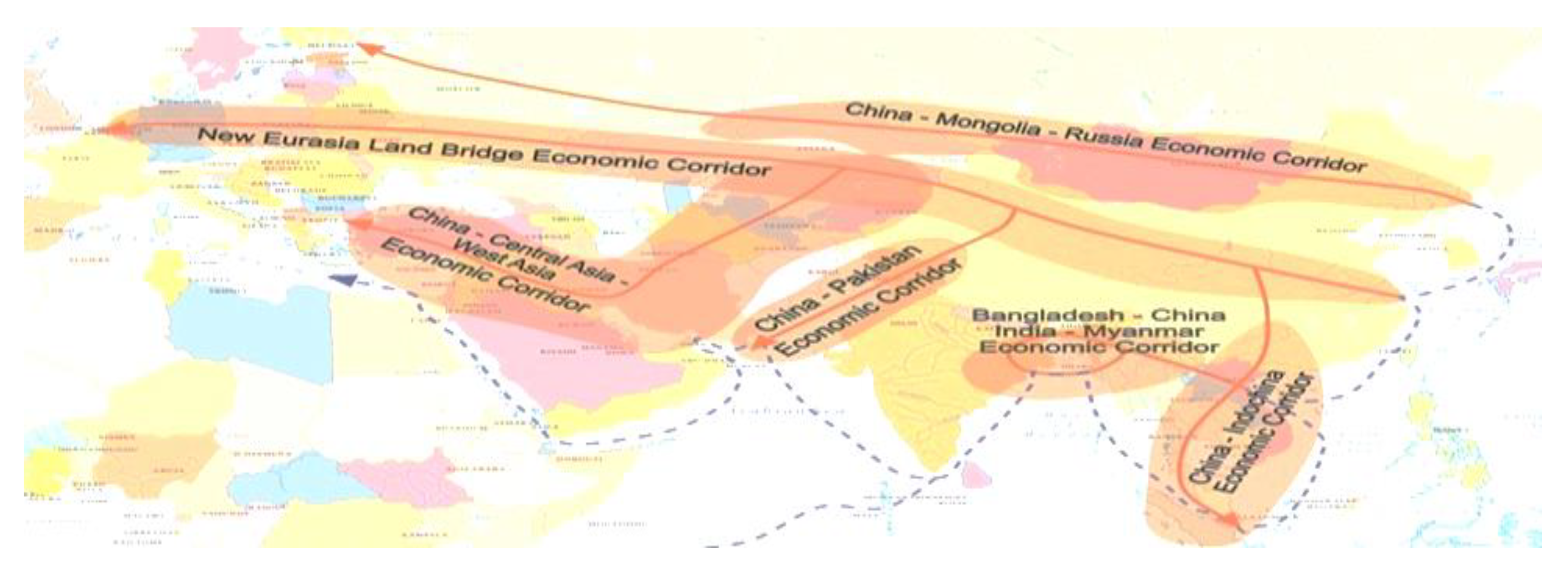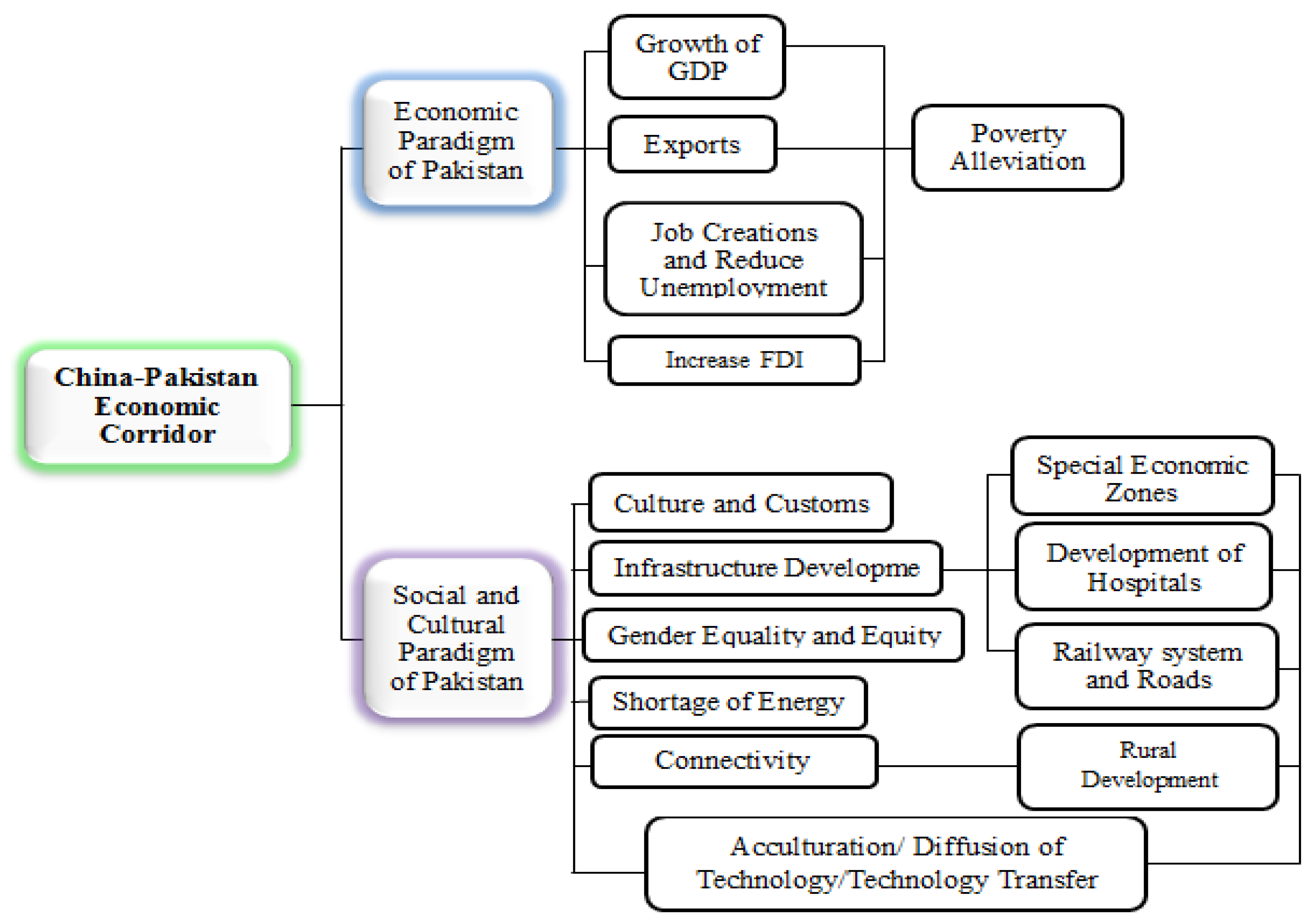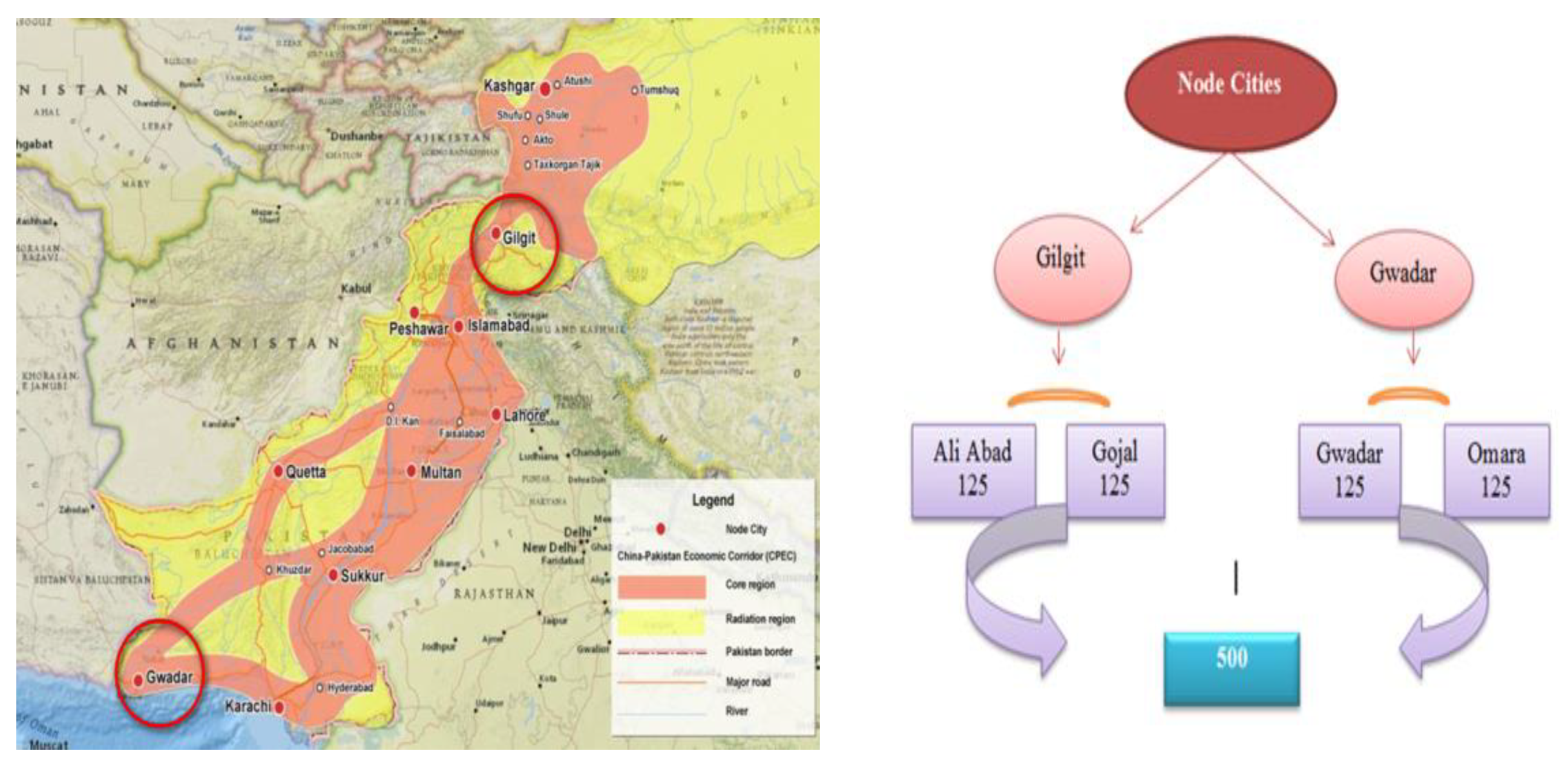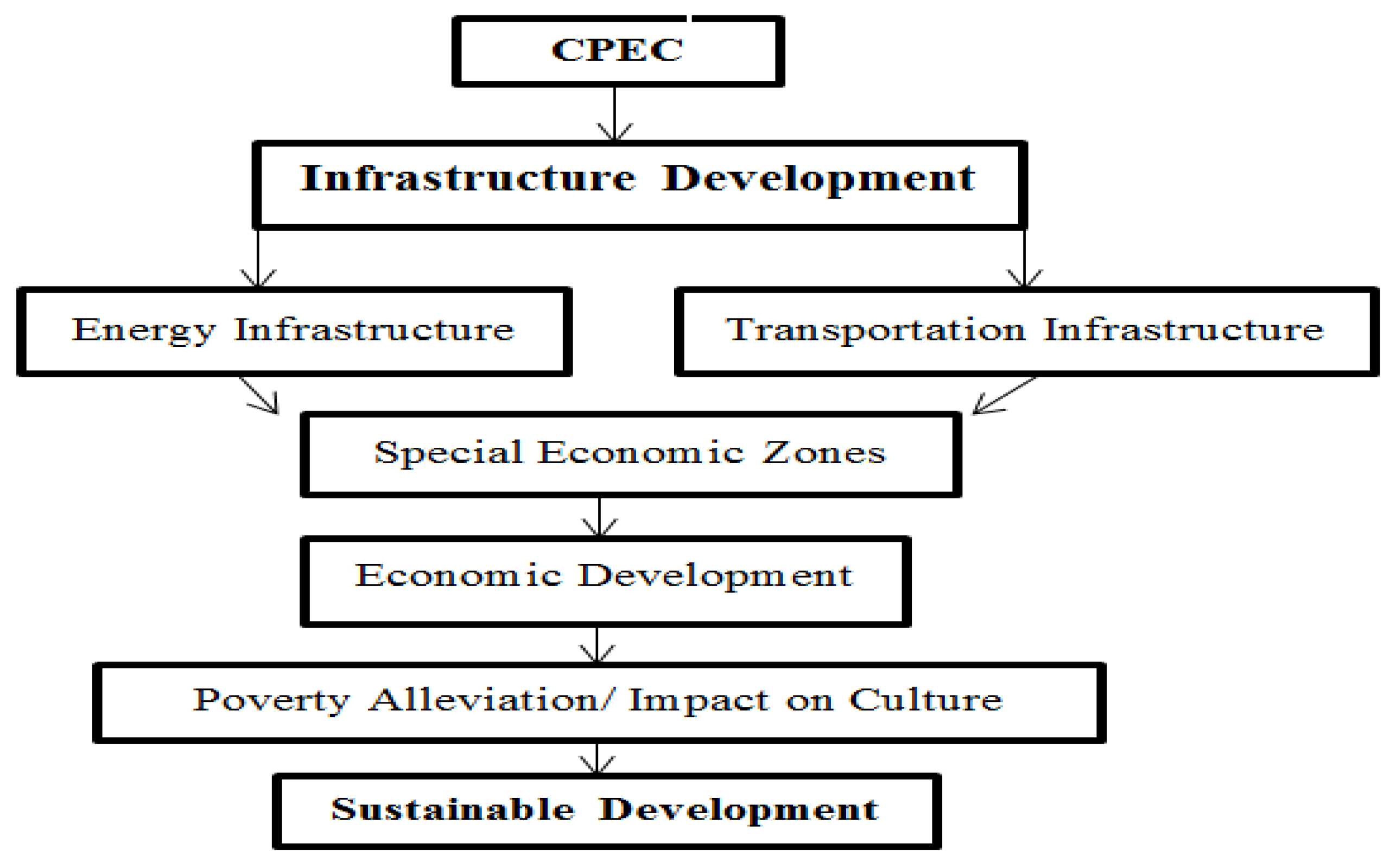Table 2 shows that 14.0% of the respondents had knowledge that the CPEC is an economic project, 22.2% of them said that the CPEC is an energy project, 26.2% of them had awareness that the CPEC is an infrastructure development project, 20.8% of them said that the CPEC is a social development project, and 16.8% of the respondents thought that the CPEC is a project which had all aforementioned aspects. Reference [
43] stated that the CPEC is a multidimensional project in Pakistan that will be helpful in urban and rural development. About 54% of survey respondents perceived that the CPEC is a rail and road route between Pakistan and China. Further, the majority of the respondents got information regarding the CPEC from electronic media, discussions, and political parties. Moreover, reference [
44] assessed that the CPEC will uplift the social development of Pakistan through the implementation of different projects such as energy production, infrastructure development, and the establishment of new industries. These projects under the CPEC will produce new job opportunities for Pakistani youth and will be helpful in the poverty alleviation. Rural, remote areas will be connected with cities. Moreover, technical and vocational centers will also improve the social condition of Pakistani society by providing training about new modern technology which will transfer to Pakistan under the CPEC. According to [
45], the CPEC project is based on the establishment of a railway network and the construction of roads, airports, an optical fiber network, energy production units, and a high-speed train between Peshawar and Karachi. All these components of the CPEC will reshape urban life and play a vital role in the urban development of Pakistan.
3.1.1. CPEC Project and Socio-Economic Development
Infrastructure projects in any society have drastic impacts in terms of socio-economic development. The China–Pakistan Economic Corridor is a multipurpose infrastructure project which will reshape the social and economic paradigm of Pakistani society. According to [
46], through the CPEC, a high tech infrastructure will be built which will be helpful in the socio-economic development of Pakistan. In the CPEC project, the Gwadar seaport has a significant geo-strategic position. Moreover, the development of Gwadar will lead to the development of Balochistan. Many local habitants of Balochistan will be able to get employment and business opportunities under the CPEC and enhance their socio-economic conditions.
Table 3 shows that 13.2% of the respondents thought that the CPEC had a role in the improvement of Pakistan’s economy, 11.8% of them said that the CPEC had a role in fulfilling the energy needs of Pakistan, 22.0% of them thought that the CPEC had role in rural and urban development, 19.6% of them said that the CPEC had a role in social development of Pakistan, and 19.6% of the respondents thought that the CPEC had a role in all aforementioned indicators of progress. Reference [
47] concluded that the CPEC is based upon the establishment of a railroad, a road (2700 km), and an oil and gas pipeline between China and Pakistan. The linkage between Pakistan and China will provide a cost-saving shipment and secure route to China for business and trade with the rest of the world. In the context of energy, reference [
48] reported that the energy projects under the CPEC will help solve the energy shortage issues and boost the economy of Pakistan. Further, the CPEC will also play an essential role in the socio-economic uplifting of Pakistan through the provision of employment opportunities to the local people, the overcoming of the energy shortage problem, the construction of new industries, the eradication of poverty, and improving living standards of the Pakistani nation. Business opportunities under the CPEC will enhance the income level of ordinary people. All the aforementioned impact of the CPEC on Pakistani society will lead towards sustainable development in Pakistan. Moreover, [
49] reported that the CPEC under the BRI will provide various kinds of opportunities and benefits for Pakistan, from socio-economic development to improved security across the country. In short, the CPEC will improve governance in Pakistan, be helpful in the eradication of poverty, and attract foreign investment.
Table 4 shows that around one-third 34.6% of the respondents thought that under the CPEC, the construction of infrastructure is going to be held in their area for rural development; 36.4% of them thought that under the CPEC, rural electrification is going to be held in their area for rural development; 10.6% and 12.8% of the respondents thought that under the CPEC, improving the agricultural sector and increasing and improving irrigation system, respectively, are going to be held in their area for rural development. Under the CPEC project, [
50] said the CPEC will enhance and speed up cargo container movement in Pakistan and China. Practical and increased transportation will also solve the problems that farmers face during the post-harvest season of the crops. The CPEC will improve the infrastructure and transportation system in rural areas of Pakistan, and farmers will be able to get more profits from their crops. Furthermore, [
51] found that most of the population of Pakistan is living in rural areas, and about 42.3% of people are involved in agriculture sector labor. The CPEC project will become a source of competition among Pakistani farmers, which will further lead towards new advance technology and innovation.
Moreover, reference [
52] stated that under the CPEC project, both China and Pakistan cooperate in agriculture fields such as demonstration of mechanization, livestock, the processing of agricultural products, the improvement of production technology, and poultry breeding. Further, the development of rural infrastructure will also play an essential role in the transportation of farm products to markets. Moreover, reference [
53] reported that the CPEC will enhance and improve regional connectivity, which reduces transportation costs. In the northern areas of Pakistan, good quality fruits and vegetables are produced but cannot be exported due to the non-availability of transportation infrastructure. In this context, northern areas will connect with airports through the CPEC, which will further be helpful in the export of agricultural products and fruits.
Table 5 shows 5.2%, 21.0%, 16.2%, and 21.4% of the respondents had thought that the CPEC project will provided gender equality, gender equity, social justice, and poverty reduction, respectively, in the life of the common man. Reference [
54] argued that the CPEC project will be helpful in the economic development of Pakistan. Further, the CPEC will also beneficial in overcoming the rising issue of unemployment in Pakistan. Moreover, the CPEC will also have an impact on the lives of ordinary people and will improve the standard of basic amenities of life and poverty reduction.
Table 6 indicates that 21.4% of the respondents said that the CPEC will improve the primary education system, 19.8% of them said that the CPEC will improve health facilities, 31.6% observed that the CPEC will establish the installation of water purification plants, and 20.4% of them noticed that all of the above discussed initiatives have started under CPEC projects for the social development of their area. Reference [
55] reported that the CPEC will attract foreign investment in the country. It will have a significant impact on the life of the common man, and, according to the Chinese Ambassador Sun Weidong, the successful completion of the CPEC will be helpful in the provision of better education, health, and job facilities. References [
56] stated that the Gwadar city will upgrade technical, vocational, and educational (universities) institutes. Further, the up-gradation of hospitals and supply of pure water will also be included in the Gwadar city development project. After the accomplishment of the Gwadar development project, Gwadar will become an important port city.
Table 7 indicates that 8.0% of the respondents said that the CPEC will establish new industries and economic zones, 20.2% of them thought that the CPEC will increase electricity production, 14.4% said that the CPEC will help gather natural resources for industries, 33.2% of them thought that the CPEC will help with rising estate activity, 18.8% of them thought that the CPEC project will encourage a shift from an agrarian society to a logistics hub, and the remaining respondents 5.4% told that all above discussed development through the CPEC will be helpful in economic development. In the scenario of new industries and special economic zones, the CPEC is a commercially centered project by the Chinese government in Pakistan. Many SEZs and industrial estates will be constructed under this project, which will further create many jobs for the local habitants. According to the chairman of Gwadar Port Authority, 40,000 job opportunities will be produced under the Gwadar port development. Reference [
57] argued that Kashghar was declared a vital transit hub that was located on the ancient silk route (ASR), and further, it is an entry point between Pakistan and China. The Chinese government is going to build SEZs in Kashghar and Gwadar, and these will play an essential role in the development of the Xinjiang province. Both SEZs will be connected through rail and road networks. The interconnectivity of both SEZs will bring socio-economic development and improve the geo-strategic position of the region. Currently, Pakistan is also facing a shortage of electricity. Reference [
58] reported that in 2014, the Chinese government declared that they will provide finance for those Chinese companies who will participate in the construction of infrastructure and energy production units in Pakistan under the CPEC project. About 33.8 USD billion is being invested in the energy sector of Pakistan by different Chinese companies. Energy production through the wind, solar, hydro, and coal are included in the CPEC, and after completion, 10,400 MW energy will be added in the national power system of Pakistan. Pakistan is rich in mineral resources, but due to a lack of technology, these resources are still unused. Reference [
59] stated that according to the plan of the Pakistani government, 21 mineral extraction and processing zones will be established under the CPEC project in all provinces. Baluchistan is very rich in mineral resources, and the government of Baluchistan is going to develop the mineral extraction and processing zones in various parts of the province such as Khuzdar (antimony, chromite) Qila Saifullah (chromite, antimony) Chaghi (chromite) Reko Diq (gold) Saindak (gold, silver) Lasbela (manganese) Kalat (iron ore) Muslim Bagh (chromite) and Gwadar (oil refinery) under the CPEC project with different Chinese companies. The construction and real estate sector of Pakistan is growing and playing an essential role in the urbanization process of remote areas. Reference [
60] estimated that the real estate sector is increasing due to the CPEC project, and, as such, the prices of property are rising. In Gwadar, the costs of property have increased about 70.0%. Further, the government of Balochistan has introduced a housing project in Gwadar with modern facilities that also increased real estate activity in the area. Moreover, the real estate sector has contributing to the economic development of Balochistan. Reference [
61] stated that across Pakistan, the prices of land have increased due to the different routes of the CPEC. In Gwadar, many private real estate developer companies and builders have launched new housing projects along the CPEC route.
Table 8 shows that 42.6% of the respondents expect enhancement in GDP growth, 16.8% of them expected improvement in gross national product (GDP), 23.8% of the estimated increase in foreign direct investment (FDI) and 16.8% of them expect growth in all aforementioned ways of development of Pakistan’s economy through CPEC projects. Reference [
62] argued that the CPEC will improve the GDP of Pakistan, and in the coming next three years, the growth of the GDP will be at least 1.5%. From 2016 to 2018, the impact of investment on the economic sector of Pakistan was 2.0%. Further, it has also been estimated that the GDP growth rate will be 6.0% each year. Moreover, the CPEC will attract private sectors to do business in Pakistan, and about 0.5% will improve the GDP through private investment. Further, reference [
63] estimated that about 50.0% of total FDI will come in Pakistan through China under the CPEC. This estimation has also been recognized by official Chinese reports statistics. The FDI received from China in the year of 2015–2016 was about 593.9 million USD, which is higher (131.3%) than that of the year 2014–2015.
Table 9 depicts that a significant majority (92.4%) of the respondents thought that free economic zones and industrial parks will be helpful in the alleviation of absolute poverty, whereas only 3.4% of the respondents were replied negatively and 4.2% had no knowledge about this opinion. Further, Reference [
58] found that about 60.0% of the people of Pakistan belong to the 30 years age group. They do not have employment and worry about the future. The projects under the CPEC, such as transportation, trade, and construction, can create thousands of new job opportunities for the unemployed people of Pakistan. As soon as the CPEC is operational, industrial and economic zones on the route of the corridor will also produce new employment opportunities. Moreover, reference [
64] reported that under the CPEC project, special economic zones are going to be established in remote areas of Pakistan, and this will be helpful in poverty reduction, employment opportunities and the development of underdeveloped regions. Moreover, special economic zones will also enhance the connectivity of different areas and improve the transportation system.
3.1.2. Influences of CPEC projects on the Culture of Pakistan
China and Pakistan are different in cultural paradigms, and the people of both countries speak a different language. It is essential for the people of both countries to learn each other’s language and to enhance people-to-people contact. When they speak each other’s languages, they can deeply understand the feelings of each other and strengthen cooperation. According to reference [
65], the process of cultural assimilation will be held, thus allowing for the emergence of new common cultural values in both societies. Moreover, cultural assimilation will also encourage people-to-people contact in both countries. For the effective implementation of the CPEC, both country’s governments need to pay special attention to the cultural dimension.
Table 10 represents the selected community’s thinking about the influences of CPEC projects on the culture of Pakistan. Around 2.0% of the respondents strongly agreed that the CPEC will change the lifestyle of the Pakistani community, 88.3% of them agreed, 5.4% of them had no opinion, 2.9% disagreed, and 1.5% of the respondents strongly disagreed. More than one-third (34.6%) of the respondents strongly agreed, 53.1% of them agreed that the CPEC project is promoting the Chinese language in Pakistan, 9.2% of them had no opinion, 2.3% disagreed, and 0.8% of them strongly disagreed. Further, reference [
66] reported that English is the dominant language in Pakistan to get a good job. In this scenario, Urdu, which is the national language of Pakistan, is losing its importance. Currently, the Chinese language is being introduced in Pakistan by educational institutes, which will further decrease the importance of the Urdu language. The CPEC is attracting many Chinese companies for business in Pakistan, and getting jobs in these companies is based upon Chinese language proficiency. In short, the CPEC will also promote the Chinese language in Pakistan. Moreover, it has been stated that both countries are taking steps to remove language barriers among the people of both countries. In this scenario, language centers are being established for the teaching of Chinese and Urdu. In Pakistan, Chinese language learning centers have been established in the Peshawar University, COMSATS Islamabad, GCU Lahore, and NUML Islamabad. In 2012, President Zardari announced the introduction of a Chinese language course at primary school levels in Sindh. Further, Chinese language institutes also host different kinds of Chinese cultural festivals. Moreover, these institutes also have launched radio stations for the Chinese language in Lahore (FM 95) and Islamabad (FM 104.6). Only 3.5% of the respondents strongly agreed that the CPEC project will encourage transformation of social customs, norms, and beliefs on the society in Pakistan, 3.8% of them agreed, 3.8% of them had no opinion, 63.1% disagreed, and 25.8% of them strongly disagreed. Only 1.7% of the respondents strongly agreed that inter-culture communication will be promoted through the CPEC project in Pakistan, 54.4% of them agreed, 11.9% of them had no opinion, 30.6% disagreed and 1.5% of them strongly disagreed. A great majority (93.3%) of the respondents strongly agreed that technological growth and innovation will be promoted through the CPEC project in Pakistan, 2.5% of them agreed, 3.8% of them had no opinion, and 0.4% disagreed. In this context, reference [
62] conducted a study on the social impacts of technological development under the CPEC. The results of the study revealed that the establishment of information technology parks and industrial parks under the CPEC are creating different kinds of opportunities for the local people of Pakistan, such as labor utilization, resource management, and business activities. Different research institutes like China–Pakistan Joint Cotton Bio-Tech Laboratory, China–Pakistan Joint Marine Research Center, and the Pak–China Science, Technology, Commerce, and Logistic Park are being established under the agreement of Economic and Technical Co-operation between China and Pakistan. Only 0.8% of the respondents strongly agreed that through CPEC project cross-cultural marriages in Pakistan, 28.8% of them agreed, 11.5% of them had no opinion, 52.9% disagreed, and 6.0% of them strongly disagreed. Reference [
67] reported that Pakistan has a complex and multicultural society in which the concept of arranged marriages is found. However, at present, a new trend of marriage is prevailing in Pakistani society—internet marriage. In this trend, many Pakistani and Chinese are marrying each other. It is a cultural impact of the CPEC on both societies, and this kind of marriage is referred to as a ‘CPEC marriage.’ Around 31.0% of the respondents strongly agreed that exchange education programs will be established through the CPEC project in Pakistan, 55.8% of them agreed, 10.6% of them had no opinion, 2.7% disagreed. Almost 40.0% of the respondents strongly agreed that the CPEC project will introduce Chinese cultural courses in the universities through Confucius institutes in Pakistan, 53.1% of them agreed, 3.8% of them had no opinion, 2.7% disagreed, and 0.8% of them strongly disagreed. Reference [
68] studied that the CPEC project will also have an impact on the education sector of Pakistan. Different educational and training institutes are going to be established in Gwadar under the CPEC project. Furthermore, both countries’ education sectors are also working to open universities on the route of the CPEC. Moreover, the Chinese government has also introduced a scholarship scheme under the CPEC project through which Pakistani students can get the chance to study in different universities in China. In different universities of Pakistan, the Confucius Institutes have been opened and are offering courses regarding Chinese culture and language. Reference [
69] stated that the Yema Group of Companies is interested in building a cultural park in China for the display of cultural products and lifestyles of both countries. Moreover, they also visited the Gilgit Baltistan region for the discovery of business and tourism opportunities. The Pakistan Technical and Vocational Training Authority (TEVTA) is not only offering different technical education courses but is also offering Chinese language courses for Pakistani youth to induct unemployed youth in various projects under the CPEC. Furthermore, the first University of Technical and Vocational Education (UTVE) in Pakistan is going to be established with the collaboration of the Tianjin University of Technology and Education of China. Only 0.8% of the respondents strongly agreed that there will be changes in food pattern due to the CPEC project in Pakistan, 29.4% of them agreed, 5.2% of them had no opinion, 32.1% disagreed, and 32.5% of them strongly disagreed. About 22.5% of the respondents strongly agreed that the CPEC will increase contact between both countries people, 69.8% of them agreed, 7.3% of them had no opinion, and 0.4% disagreed. Around 22.0% of the respondents strongly agreed that transmission of materialistic culture will occur due to the CPEC project in Pakistan, 32.7% of them agreed, 11.0% of them had no opinion, 32.5% disagreed. and 2.1% of them strongly disagreed. A major proportion 46.5% of the respondents strongly agreed that landscape culture is changing due to the CPEC project in Pakistan, 43.3% of them agreed, 9.6% of them had no opinion, and 0.6% disagreed with this opinion. About 14.4% of the respondents strongly agreed that TV channels are broadcasting Chinese content due to the CPEC project in Pakistan, 77.7% of them agreed, 5.4% of them had no opinion, and 2.5% disagreed with this opinion.










